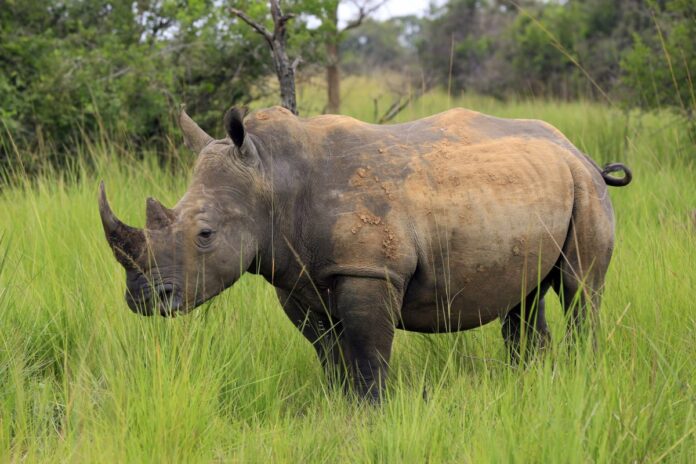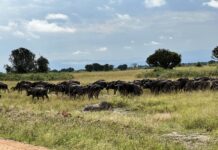Two male rhinos have been born in two days at Ziwa Rhino Sanctuary bringing the total number at the Sanctuary to 38. Malaika gave birth to her fourth calf while her sister Uhuru gave birth to her third calf at the sanctuary.
Location of Ziwa Rhino Sanctuary
The Ziwa Rhino Sanctuary is located in Nakasongola district, approximately 180 kilometers north of Kampala, Uganda’s capital city. It was established in 2005 by the Rhino Fund Uganda, a non-profit organization, in collaboration with the Uganda Wildlife Authority. The sanctuary covers an area of 70 square kilometers and is home to now 38 white rhinos.
About Ziwa Rhino Sanctuary
Ziwa Rhino Sanctuary is a symbol of hope for rhinos in Uganda. Rhinos are one of the Big Five found in Uganda. It is a significant conservation project that provides a safe environment for rhinos to breed and thrive, with the ultimate aim of reintroducing them to the wild. The sanctuary not only provides an opportunity for visitors to see rhinos in their natural habitat but also raises awareness about rhino conservation.
The sanctuary is a crucial conservation project that aims to reintroduce rhinos to the wild in Uganda. The sanctuary provides a safe environment for rhinos to breed and thrive, with a focus on enhancing their survival chances in the wild. The rhinos in the sanctuary are monitored 24/7 by a team of rangers and veterinary doctors.
Visitors to the Ziwa Rhino Sanctuary have the opportunity to track rhinos on foot. The guided walks take visitors through the savannah grasslands, where they can see rhinos grazing and interacting with each other. The walk takes approximately 1-2 hours and is led by an experienced ranger who provides information about the rhinos, their behavior, and their habitat.
Apart from rhino tracking, the sanctuary offers other activities such as bird watching, nature walks, and canoe rides. The sanctuary also has a restaurant and accommodation facilities for visitors who want to spend the night in the sanctuary.
The Ziwa Rhino Sanctuary is not just a tourist attraction but also a significant conservation project. The sanctuary has contributed significantly to the conservation of rhinos in Uganda. The Rhino Fund Uganda has partnered with various organizations, both local and international, to raise awareness about rhino conservation and provide support for the sanctuary‘s operations.
The 7 Reknown Rhino Behaviours
Aggression: Rhinos are generally solitary animals, but they can become aggressive when they feel threatened or territorial. Rhinos can charge at speeds of up to 50 km/h and can use their large horn to defend themselves or their territory.
Communication: Rhinos communicate with each other through a variety of sounds and body language. They use vocalizations such as snorts, grunts, and bellows to communicate with other rhinos. They also use their ears, tail, and body posture to signal their intentions.
Grazing: Rhinos are herbivores and spend much of their time grazing on grasses and other plants. They use their wide lips to grip the grass and their strong teeth to tear it off.
Social behavior: Although rhinos are generally solitary animals, they may occasionally gather in small groups. For example, mothers will stay with their calves for up to two years, and males will sometimes form temporary groups during mating season.
Marking territory: Rhinos mark their territory by using their horns to scratch the ground and by leaving piles of dung as a visual marker. This helps other rhinos know that the area is occupied.
Bathing: Rhinos love water and will often take long baths to cool off or to remove parasites from their skin. They may also wallow in mud to protect themselves from the sun and insects.
Sleep: Rhinos are active during the day and rest at night. They often sleep standing up, using their large size to deter predators.
5 known Rhino Habitats
In Uganda, the rhinos are only found at the Uganda Wildlife Education Center in Entebbe and at the Ziwa Rhino Sanctuary. It is easy to hire a driver who can drive you to any of these places to either view the rhinos or better still engage in the real rhino tracking. Below are the renowned rhino habitats worldwide;
Grasslands: Many species of rhinos, including the white rhino, live in grassland habitats. These areas are characterized by tall grasses and are often found in savannas or prairies.
Woodlands: Some rhino species, such as the black rhino, are found in woodland habitats. These areas are characterized by trees and shrubs, and they provide rhinos with shelter and food.
Swamps and wetlands: The greater one-horned rhino is found in swamp and wetland habitats, where they feed on aquatic plants and grasses. These areas are also important for other wetland species.
Mountains: The Javan and Sumatran rhinos are found in mountainous habitats, where they live in dense forests and steep slopes.
Deserts: The white rhino subspecies, the desert-adapted rhino, is found in desert habitats in Namibia and South Africa. These areas are characterized by arid climates and sparse vegetation.






